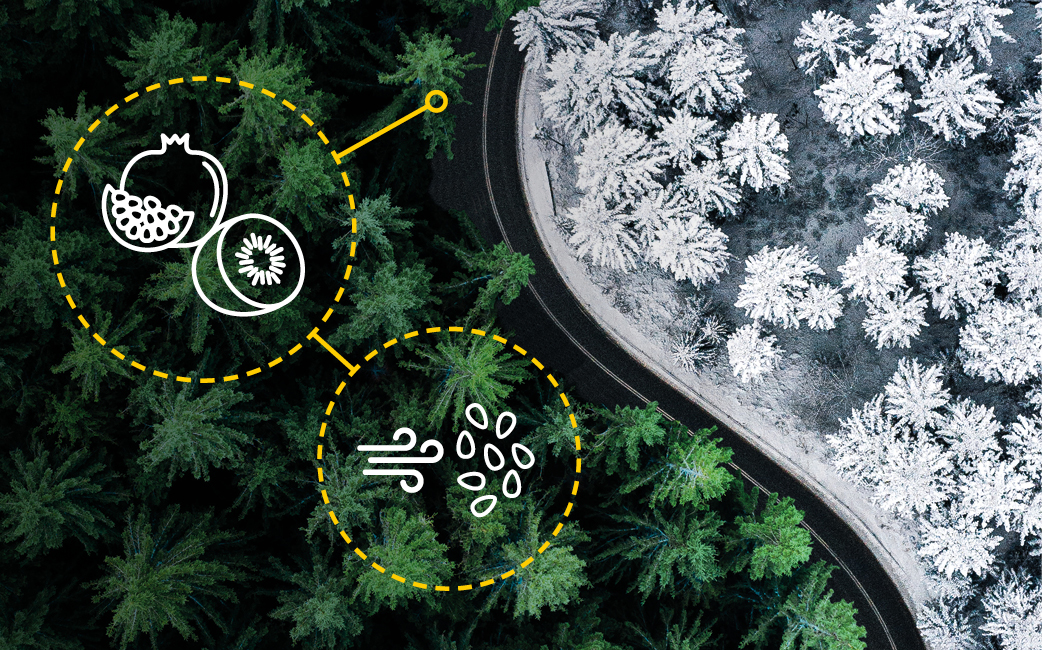Most plants are only able to move by dispersal of their seeds or spores from the parent plant to a new location, where a child plant can germinate, take root and grow. Dispersal allows plant populations to get larger, and to reach new locations and habitats. This is especially important if the population has filled its local habitat patch, or the environment is changing (for example as a result of climate change) and the population needs to move somewhere with more favourable conditions.
Plants have evolved many different strategies and structures to give them the best chance of dispersing their seeds to appropriate environments. Some plants encase their seeds in fruit to entice passing animals to eat them. After carrying the seeds in their gut, the animals will deposit them onto the ground some distance away in their faeces. Other plants rely on the wind to disperse their seeds.
When a plant releases seeds, each one travels a different distance, depending on the journey that it takes after leaving the parent plant. If two wind-dispersed seeds fall off a tree, one may be released on a still day, fall vertically, and land close to the parent. The other may be carried metres or even kilometres by the wind. Because of this variation, dispersal distances are usually thought about in terms of probabilities, which define the dispersal kernel. For example, what is the distance from the parent plant within which half the seeds are likely to land, with the other half travelling further? What is the probability that a seed will end up as far as 100 metres away from its parent plant?
Pieter the Seed Eater

Seeds that are well adapted for wind dispersal have structures that increase drag, making them fall slowly, spending more time in the air meaning they are more likely to travel further.

Shortly after a winged seed is released, it reaches a constant falling speed (terminal velocity) that depends on the shape and size of the seed. Seeds that are well adapted for wind dispersal have structures that increase drag, making them fall slowly. These seeds spend more time in the air so they are more likely to travel further from the parent tree than a fast falling seed. In the past, ecologists have measured the terminal velocity of seeds using stopwatches, or using lasers. However, stopwatches are inaccurate and lasers are expensive, so we built Pieter the Seed Eater: a tall tube fitted with a Raspberry Pi computer and camera near the base. These record a sequence of images, assess which timestamped images contain a falling seed, and then calculate how far the seed fell and hence how fast it was travelling.
Radiata pine (Pinus radiata) is an alien species introduced to New Zealand in 1858 for forestry, now present on 1.5 million hectares of land – around 5% of the national landmass. We want to know how rapidly it might spread from plantations, and where it might go. To investigate terminal velocity of P. radiata seeds, we visited three locations in Canterbury, NZ, collecting five cones from each of five trees at each location. We extracted ten seeds from each cone, making 750 seeds in total, and measured their terminal velocity using Pieter the Seed Eater.

^ Radiata pine in New Zealand.
The terminal velocity of P. radiata seeds is very variable: on average, seeds fell at a terminal velocity between 0.8 and 1.1 metres per second (ms-1), but they could be as slow as 0.58 ms-1 or as fast as 1.42 ms-1. To put this into context, a seed falling from 30 metres could take between 21 and 50 seconds to reach the ground. With a 50 km/h wind (the average wind speed in Canterbury on warm summer days, when pine cones are most likely to open and release seeds), 5-10% of the slowest seeds are likely to travel over 750 metres before reaching the ground, a distance that is extremely unlikely to be reached by any of the faster falling seeds.
Terminal velocity also differed between seeds collected at low, medium and high elevation, meaning individual populations of the same species may have different dispersal rates, as well as among seeds within a cone, possibly as a result of the differently shaped seeds at each end of the cone. The key message from this research is that we should never assume that all seeds from a single tree species fall at the same speed. Ignoring variation makes us underestimate how likely long-distance dispersal events are, leading to poor predictions of the rate of advance
of tree populations across the landscape.
Pieter’s diet is now expanding to take in a whole range of pine species, but there are many other species of tree around the world that also have winged seeds, in a variety of fascinating shapes. Pieter doesn’t have time to eat all the seeds himself, but you can join in and design your own seed eater, contribute your data to an online database and explore questions about their data using visualisation tools for dispersal equations and population spread.
For more information, see btle.york.ac.uk/seedeater
Learning resource
We have created learning notes to assist students and educators to further investigate the topics covered in this article. You can download the learning resource here »


